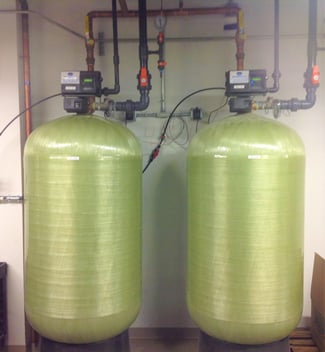Q: Why is my steam firetube boiler repeatedly locking out on low water, yet there is plenty of water in the sight glass?
A: A boiler will automatically shut down (“lockout”) when it senses a problem. In this case, the lockout is displaying low water when there is still water in the boiler. There are a couple of reasons this may happen: bad water chemistry and possible surging.
A clean boiler is a functioning boiler and failure to keep a boiler clean can create this lockout situation. It can even cause permanent damage. During boiler assembly, grease, lubricants and other materials can accumulate inside the boiler and cause tension at the water line. If there is oil or other foreign materials floating on the surface, steam cannot escape and that’s when surging will occur.
Water chemistry must be controlled at all times and boiler water must be treated in order to be maintained. Over time, corrosion can lead to scale, sludge and deposits in the water. Scale can dramatically affect the life expectancy of your equipment and also significantly lessen the efficiency of the unit.

A water softener system can be used to remove the calcium, magnesium and certain other metal cations in hard water, which can prolong the life of the pipes for boiler systems and equipment.
Details regarding water softener systems:
- A proper flow size must be used and should have a fully automatic regeneration controller
- Fiberglass construction or stainless steel is recommended for longevity
- Re-bedding should be done between 2-5 years based on usage of system and the quality of the city incoming water
- A manual bypass should be added for service and if the system is off-line
Corrosion can be caused by oxygen and dissolved gases like carbon dioxide and ammonia. Most corrosion occurs in boilers when the temperature is at a higher degree. This is because chemicals become less effective as the temperature of the water rises. The higher the water temperature, the less oxygen the water will contain. Unfortunately, the high temperature of the water also causes the corrosion to occur faster due to the chemical reaction of the oxygen. Treating boiler water will coat the tubes, resulting in proper water chemistry that produces suitable steam. It also prevents corrosion.
Follow these steps to avoid scale buildup:
- Properly pre-heat
- Chemically treat your feed water
- Ensure daily bottom blowdown, surface blowdown and low water cutoff(s) blowdown
Blowing down a boiler consists of manually opening designated valves at the front, rear, sides and near the top of the boiler to drain the potentially poor water. If the water in the boiler sits for too long, the minerals will begin to settle on the bottom of the boiler or the tubes (depending on the model of the boiler).
Blowing down your boiler only takes a few moments but it helps your system last longer and operate more efficiently. Please note that each valve should be manually opened one at a time and for no more than 3-5 seconds. Too much blowdown will lead to a very dangerous “low water” condition in a hot boiler. A common misconception is that boiler blowdown is not required if you are using proper water treatment. This is not the case and you should always blowdown your boiler regardless of the appropriate chemicals that are used.
Finally, skimming above the waterline will also keep your steam boiler clean. The highly qualified service technicians at The Wilkinson Companies can follow the proper procedure to skim the surface of your boiler and get it back to proper working order. If you’re having lockout issues, please contact us so we can get your boiler back online safely.
Do you have a question you’d like to see answered on our blog? Submit it to eschlumper@gtwilkinson.com. We look forward to hearing from you!

